Turkish War of Independence
- العربية
- Asturianu
- Azərbaycanca
- تۆرکجه
- বাংলা
- Башҡортса
- Беларуская
- Български
- Bosanski
- Català
- Čeština
- Dansk
- Deutsch
- Eesti
- Ελληνικά
- Español
- Esperanto
- Euskara
- فارسی
- Français
- 한국어
- Հայերեն
- हिन्दी
- Hrvatski
- Bahasa Indonesia
- Italiano
- עברית
- Jawa
- ქართული
- Kurdî
- Latviešu
- Magyar
- Македонски
- مازِرونی
- Монгол
- Nederlands
- 日本語
- Norsk bokmål
- پنجابی
- پښتو
- Polski
- Português
- Qırımtatarca
- Română
- Русский
- Scots
- Shqip
- Simple English
- Slovenčina
- Српски / srpski
- Srpskohrvatski / српскохрватски
- Suomi
- Svenska
- ไทย
- Türkçe
- Українська
- اردو
- Tiếng Việt
- 吴语
- 粵語
- 中文
This article's lead section may be too long. Please read the length guidelines and help move details into the article's body. (June 2023) |
| Turkish War of Independence | |||||||||
|---|---|---|---|---|---|---|---|---|---|
| Part of the Revolutions of 1917–1923 in the aftermath of World War I | |||||||||
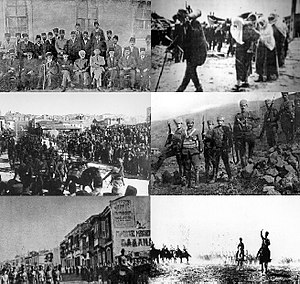 Clockwise from top left: Delegation gathered in Sivas Congress to determine the objectives of the Turkish National Movement; Turkish civilians carrying ammunition to the front; Kuva-yi Milliye infantry; Turkish horse cavalry in chase; Turkish Army's capture of Smyrna; troops in Ankara's Ulus Square preparing to leave for the front. | |||||||||
| |||||||||
| Belligerents | |||||||||
|
Turkish Nationalists: Also:
|
Allied Powers:
(in 1920) Supported by: (in 1921) | ||||||||
| Commanders and leaders | |||||||||
|
Ethem the Circassian (until 1920) |
| ||||||||
| Strength | |||||||||
|
November 1920: 86,000 (creation of regular army)[18] August 1922: 271,000[19][note 1] |
1922: 200,000[21]–250,000[22][23] | ||||||||
| Casualties and losses | |||||||||
|
22,690 died of disease[30] 5,362 died of wounds or other non-combat causes[30] 35,000 wounded[29] 7,000 prisoners[31][f] |
18,095 missing 48,880 wounded 4,878 died outside of combat 13,740 prisoners[32][33][note 2] 3,000+ prisoners[42] | ||||||||
|
264,000 Greek civilians killed[43] 60,000–250,000 Armenian civilians killed[44][45] 15,000+ Turkish civilians killed in the Western Front[46] 30,000+ buildings and 250+ villages burnt to the ground by the Hellenic Army and Greek/Armenian rebels.[47][48][49][50][51] | |||||||||
|
Notes
| |||||||||
The Turkish War of Independence While World War I ended for the Ottoman Empire with the Armistice of Mudros, the Allied Powers continued occupying and securing land per the Sykes–Picot Agreement, as well as to facilitate the prosecution of former members of the Committee of Union and Progress and those involved in the Armenian genocide.[59][60] Ottoman military commanders therefore refused orders from both the Allies and the Ottoman government to surrender and disband their forces. In an atmosphere of turmoil throughout the remainder of the empire, sultan Mehmed VI dispatched Mustafa Kemal Pasha (Atatürk), a well-respected and high-ranking general, to Anatolia to restore order; however, Mustafa Kemal became an enabler and eventually leader of Turkish Nationalist resistance against the Ottoman government, Allied powers, and separatists.
In an attempt to establish control over the power vacuum in Anatolia, the Allies agreed to launch a Greek In the ensuing war, Turkish and Syrian forces defeated the French in the south, and remobilized army units went on to partition Armenia with the Bolsheviks, resulting in the Treaty of Kars (October 1921). The Western Front of the independence war is known as the Greco-Turkish War, in which Greek forces at first encountered unorganized resistance. However, İsmet Pasha (İnönü)'s organization of militia into a regular army paid off when Ankara forces fought the Greeks in the First and Second Battle of İnönü. The Greek army emerged victorious in the Battle of Kütahya-Eskişehir and decided to drive on the Nationalist capital of Ankara, stretching their supply lines. The Turks checked their advance in the Battle of Sakarya and eventually counter-attacked in the Great Offensive, which expelled Greek forces from Anatolia in the span of three weeks. The war effectively ended with the recapture of İzmir and the Chanak Crisis, prompting the signing of another armistice in Mudanya.
The Grand National Assembly in Ankara was recognized as the legitimate Turkish government, which signed the The ethnic demographics of the modern Turkish Republic were significantly impacted by the earlier Armenian genocide and the deportations of Greek-speaking, Orthodox Christian Rum people.[62] The Turkish Nationalist Movement carried out massacres and deportations to eliminate native Christian populations—a continuation of the Armenian genocide and other ethnic cleansing operations during World War I.[63] Following these campaigns of ethnic cleansing, the historic Christian presence in Anatolia was destroyed, in large part, and the Muslim demographic had increased from 80% to 98%.[62]
Following the chaotic politics of the Second Constitutional Era, the Ottoman Empire came under the control of the Committee of Union and Progress in a coup in 1913, and then further consolidated its control after the assassination of Mahmud Shevket Pasha.[citation needed] Founded as a radical revolutionary group seeking to prevent a collapse of the Ottoman Empire, by the eve of World War I it decided that the solution was to implement nationalist and centralizing policies. The CUP reacted to the losses of land and the expulsion of Muslims from the Balkan Wars by turning even more nationalistic. Part of its effort to consolidate power was to proscribe and exile opposition politicians from the Freedom and Accord Party to remote Sinop.[citation needed]
The World War I would be the nail in the coffin of Ottomanism, a monarchist and multicultural nationalism. Mistreatment of non-Turk groups after 1913, and the general context of great socio-political upheaval that occurred in the aftermath of World War I, meant many minorities now wished to divorce their future from imperialism to form futures of their own by separating into (often republican) nation-states.[64]
The armistice was signed because the Ottoman Empire had been defeated in important fronts, but the military was intact and retreated in good order. Unlike other Central Powers, the Allies did not mandate an abdication of the imperial family as a condition for peace, nor did they request the Ottoman Army to dissolve its general staff. Though the army suffered from mass desertion throughout the war which led to banditry, there was no threat of mutiny or revolutions like in Germany, Austria-Hungary, or Russia. This is despite famine and economic collapse that was brought on by the extreme levels of mobilization, destruction from the war, disease, and mass murder since 1914.[64]
Due to the Turkish nationalist policies pursued by the CUP against Ottoman Christians by 1918 the Ottoman Empire held control over a mostly homogeneous land of Muslims from Eastern Thrace to the Persian border. These included mostly Turks, as well as Kurds, Circassians, and Muhacir groups from Rumeli. Most Muslim Arabs were now outside of the Ottoman Empire and under Allied occupation, with some "imperialists" still loyal to the Ottoman Sultanate-Caliphate, and others wishing for independence or Allied protection under a League of Nations mandate. Sizable Greek and Armenian minorities remained within its borders, and most of these communities no longer wished to remain under the Empire.[66]
On 30 October 1918, the On 13 November 1918, a French brigade entered Constantinople to begin a de facto A wave of seizures took place in the rest of the country in the following months. Citing Article VII, British forces demanded that Turkish troops evacuate Other commanders began refusing orders from the Ottoman government and the Allied powers. After Mustafa Kemal Pasha returned to Constantinople, Following the occupation of Constantinople, A general amnesty was soon issued, allowing the exiled and imprisoned dissidents persecuted by the CUP to return to Constantinople. Vahdettin invited the pro- With all the chaotic politics in the capital and uncertainty of the severity of the incoming peace treaty, many Ottomans looked to Washington with the hope that the application of Wilsonian principles would mean Constantinople would stay Turkish, as Muslims outnumbered Christians 2:1. The United States never declared war on the Ottoman Empire, so many imperial elite believed Washington could be a neutral arbiter that could fix the empire's problems. Halide Edip (Adıvar) and her Wilsonian Principles Society led the movement that advocated for the empire to be governed by an American League of Nations Mandate (see United States during the Turkish War of Independence).[82] American diplomats attempted to ascertain a role they could play in the area with the Harbord and King–Crane Commissions. However, with the collapse of Woodrow Wilson's health, the United States diplomatically withdrew from the Middle East to focus on Europe, leaving the Entente powers to construct a post-Ottoman order.
The Entente would have arrived at Constantinople to discover an administration attempting to deal with decades of accumulated refugee crisis. The new government issued a proclamation allowing for deportees to return to their homes, but many Greeks and Armenians found their old homes occupied by desperate Rumelian and Caucasian Muslim refugees which were settled in their properties during the First World War. Ethnic conflict restarted in Anatolia; government officials responsible for resettling Christian refugees often assisted Muslim refugees in these disputes, prompting European powers to continue bringing Ottoman territory under their control.[83][84] Of the 800,000 Ottoman Christian refugees, approximately over half returned to their homes by 1920. Meanwhile 1.4 million refugees from the Russian Civil War would pass through the Turkish straits and Anatolia, with 150,000 White émigrés choosing to settle in Istanbul for short or long term (see Evacuation of the Crimea).[85] Many provinces were simply depopulated from years of fighting, conscription, and ethnic cleansing (see Ottoman casualties of World War I). The province of Yozgat lost 50% of its Muslim population from conscription, while according to the governor of Van, almost 95% of its prewar residents were dead or internally displaced.[86]
Administration in much of the Anatolian and Thracian countryside would soon all but collapse by 1919. Army deserters who turned to With Anatolia in practical anarchy and the Ottoman army being questionably loyal in reaction to Allied land seizures, Mehmed VI established the military inspectorate system to reestablish authority over the remaining empire. Encouraged by Karabekir and Edmund Allenby, he assigned[90] Mustafa Kemal Pasha (Atatürk) as the inspector of the Ninth Army Troops Inspectorate –based in Erzurum– to restore order to Ottoman military units and to improve internal security on 30 April 1919, with his first assignment to suppress a rebellion by Greek rebels around the city of Samsun.[91]
Mustafa Kemal was a well known, well respected, and well connected army commander, with much prestige coming from his status as the "Hero of Mustafa Kemal had earlier declined to become the leader of the Sixth Army headquartered in Nusaybin.[95] But according to Patrick Balfour, through manipulation and the help of friends and sympathizers, he became the inspector of virtually all of the Ottoman forces in Anatolia, tasked with overseeing the disbanding process of remaining Ottoman forces.[96] Kemal had an abundance of connections and personal friends concentrated in the post-armistice War Ministry, a powerful tool that would help him accomplish his secret goal: to lead a nationalist movement to safeguard Turkish interests against the Allied powers and a collaborative Ottoman government.
The day before his departure to Samsun on the remote Black Sea coast, Kemal had one last audience with Sultan Vahdettin, where he affirmed his loyalty to the sultan-caliph. It was in this meeting that they were informed of the botched occupation ceremony of Smyrna (İzmir) by the Greeks.[97] He and his carefully selected staff left Constantinople aboard the old steamer SS Bandırma on the evening of 16 May 1919.[98]
On 19 January 1919, the Greece justified their territorial claims of Ottoman land through the At the Paris Peace Conference, competing claims over Most historians mark the Greek landing at Smyrna on 15 May 1919 as the start date of the Turkish War of Independence as well as the start of the "Kuva-yi Milliye Phase". The occupation ceremony from the outset was tense from nationalist fervor, with Ottoman Greeks greeting the soldiers with an ecstatic welcome, and Ottoman Muslims protesting the landing. A miscommunication in Greek high command led to an Evzone column marching by the municipal Turkish barracks. The nationalist journalist Hasan Tahsin fired the "first bullet"[note 4] at the Greek standard bearer at the head of the troops, turning the city into a warzone. Süleyman Fethi Bey was murdered by bayonet for refusing to shout "Zito Venizelos" (meaning "long live Venizelos"), and 300–400 unarmed Turkish soldiers and civilians and 100 Greek soldiers and civilians were killed or wounded.[104]
Greek troops moved from Smyrna outwards to towns on the Karaburun peninsula; to Selçuk, situated a hundred kilometres south of the city at a key location that commands the fertile Küçük Menderes River valley; and to Menemen towards the north. Guerilla warfare commenced in the countryside, as Turks began to organize themselves into irregular guerilla groups known as Kuva-yi Milliye (national forces), which were soon joined by Ottoman soldiers, bandits, and disaffected farmers. Most Kuva-yi Milliye bands were led by rogue military commanders and members of the Special Organization. The Greek troops based in cosmopolitan Smyrna soon found themselves conducting counterinsurgency operations in a hostile, dominantly Muslim hinterland. Groups of Ottoman Greeks also formed contingents that cooperated with the Greek Army to combat Kuva-yi Milliye within the zone of control. A massacre of Turks at Menemen was followed up with a battle for the town of Aydın, which saw intense intercommunal violence and the razing of the city. What was supposed to be a peacekeeping mission of Western Anatolia instead inflamed ethnic tensions and became a counterinsurgency.
The reaction of Greek landing at Smyrna and continued Allied seizures of land served to destabilize Turkish civil society. Ottoman bureaucrats, military, and bourgeoisie trusted the Allies to bring peace, and thought the terms offered at Mudros were considerably more lenient than they actually were.[105] Pushback was potent in the capital, with 23 May 1919 being largest of the Sultanahmet Square demonstrations organized by the Turkish Hearths against the Greek occupation of Smyrna, the largest act of civil disobedience in Turkish history at that point.[106] The Ottoman government condemned the landing, but could do little about it. Ferid Pasha tried to resign, but was urged by the sultan to stay in his office.
Mustafa Kemal Pasha and his colleagues stepped ashore in Samsun on 19 May[90] and set up their first quarters in the Mıntıka Palace Hotel. British troops were present in Samsun,[107] and he initially maintained cordial contact.[108] He had assured Damat Ferid about the army's loyalty towards the new government in Constantinople.[109] However, behind the government's back, Kemal made the people of Samsun aware of the Greek and Italian landings, staged discreet mass meetings, made fast connections via telegraph with the army units in Anatolia, and began to form links with various Nationalist groups. He sent telegrams of protest to foreign embassies and the War Ministry about British reinforcements in the area and about British aid to Greek brigand gangs. After a week in Samsun, Kemal and his staff moved to Havza. It was there that he first showed the flag of the resistance.[110]
Mustafa Kemal wrote in his memoir that he needed nationwide support to justify armed resistance against the Allied occupation. His credentials and the importance of his position were not enough to inspire everyone. While officially occupied with the disarming of the army, he met with various contacts in order to build his movement's momentum. He met with On 23 June, High Commissioner Admiral Calthorpe, realising the significance of Mustafa Kemal's discreet activities in Anatolia, sent a report about the Pasha to the By early July, Mustafa Kemal Pasha received telegrams from the sultan and Calthorpe, asking him and Refet to cease his activities in Anatolia and return to the capital. Kemal was in Erzincan and did not want to return to Constantinople, concerned that the foreign authorities might have designs for him beyond the sultan's plans. Before resigning from his position, he dispatched a circular to all nationalist organizations and military commanders to not disband or surrender unless for the latter if they could be replaced by cooperative nationalist commanders.[115] Now only a civilian stripped of his command, Mustafa Kemal was at the mercy of the new inspector of Third Army (renamed from Ninth Army) Karabekir Pasha, indeed the War Ministry ordered him to arrest Kemal, an order which Karabekir refused.[115]
The Following the congress, the Committee of Representation relocated to Sivas. As announced in the Amasya Circular, a new congress was held there in September with delegates from all Anatolian and Thracian provinces. The Sivas Congress repeated the points of the National Pact agreed to in Erzurum, and united the various regional Defence of National Rights Associations organizations, into a united political organisation: Anatolia and Rumeli Defence of Rights Association (A-RMHC), with Mustafa Kemal as its chairman. In an effort show his movement was in fact a new and unifying movement, the delegates had to swear an oath to discontinue their relations with the CUP and to never revive the party (despite most present in Sivas being previous members).[119] It was also decided there that the Ottoman Empire should not be a League of Nations mandate under the United States, especially after the U.S Senate failed to ratify American membership in the League.[120] Momentum was now on the Nationalists' side. A plot by a loyalist Ottoman governor and a British intelligence officer to arrest Kemal before the Sivas Congress led to the cutting of all ties with the Ottoman government until a new election would be held in the lower house of parliament, the Chamber of Deputies. In October 1919, the last Ottoman governor loyal to Constantinople fled his province. Fearing the outbreak of hostilities, all British troops stationed in the Black Sea coast and Kütahya were evacuated. Damat Ferid Pasha resigned, and the sultan replaced him with a general with nationalist credentials: Ali Rıza Pasha.[121] On 16 October 1919, Ali Rıza and the Nationalists held negotiations in Amasya. They agreed in the Amasya Protocol that an election would be called for the Ottoman Parliament to establish national unity by upholding the resolutions made in the Sivas Congress, including the National Pact.
By October 1919, the Ottoman government only held de facto control over Constantinople; the rest of the Ottoman Empire was loyal to Kemal's movement to resist a partition of Anatolia and Thrace. Within a few months Mustafa Kemal went from General Inspector of the Ninth Army to a renegade military commander discharged for insubordination to leading a homegrown anti-Entente movement that overthrew a government and driven it into resistance.[122]
In December 1919, an Mustafa Kemal was elected an MP from Erzurum, but he expected the Allies neither to accept the Harbord report nor to respect his parliamentary immunity if he went to the Ottoman capital, hence he remained in Anatolia. Mustafa Kemal and the Committee of Representation moved from Sivas to Ankara so that he could keep in touch with as many deputies as possible as they traveled to Constantinople to attend the parliament.
Though Ali Rıza Pasha called the election as per the Amasya Protocol to keep unity between the " On 12 January 1920, the last session of the From February to April, leaders of Britain, France, and Italy met in London to discuss the partitioning of the Ottoman Empire and the crisis in Anatolia. The British began to sense that the elected Ottoman government was under Kemalist influence and if left unchecked, the Entente could once again find themselves at war with the Empire. The Ottoman government was not doing all that it could to suppress the Nationalists.
Mustafa Kemal manufactured a crisis to pressure the Istanbul government to pick a side by deploying Kuva-yi Milliye towards İzmit. The British, concerned about the security of the Bosporus Strait, demanded Ali Rıza Pasha to reassert control over the area, to which he responded with his resignation to the sultan.
As they were negotiating the partition of the Ottoman Empire, the Allies were growing increasingly concerned about the Turkish National Movement. To this end, the Allied occupational authorities in Istanbul began to plan a raid to arrest nationalist politicians and journalists along with occupying military and police installations and government buildings. On 16 March 1920, the coup was carried out; several Royal Navy warships were anchored in the Galata Bridge to support British forces, including the Indian Army, while they carried out the arrests and occupied several government buildings in the early hours of the morning.[128]
An Indian Army operation, the Şehzadebaşı raid, resulted in 5 Ottoman soldiers from the 10th Infantry Division being killed when troops raided their barracks. Among those arrested were the senior leadership of the Turkish National Movement and former members of the CUP. 150 arrested Turkish politicians accused of war crimes were interned in Malta and became known as the Malta exiles.[128]
Mustafa Kemal was ready for this move. He warned all the Nationalist organisations that there would be misleading declarations from the capital. He warned that the only way to counter Allied movements was to organise protests. He declared "Today the Turkish nation is called to defend its capacity for civilization, its right to life and independence – its entire future".
On 18 March, the Chamber of Deputies declared that it was unacceptable to arrest five of its members, and dissolved itself. Mehmed VI confirmed this and declared the end of Constitutional Monarchy and a return to absolutism. University students were forbidden from joining political associations inside and outside the classroom.[129] With the lower elected Chamber of Deputies shuttered, the Constitution terminated, and the capital occupied; Sultan Vahdettin, his cabinet, and the appointed Senate were all that remained of the Ottoman government, and were basically a puppet regime of the Allied powers. Grand Vizier Salih Hulusi Pasha declared Mustafa Kemal's struggle legitimate, and resigned after less than a month in office. In his place, Damat Ferid Pasha returned to the premiership. The Sublime Porte's decapitation by the Entente allowed Mustafa Kemal to consolidate his position as the sole leader of Turkish resistance against the Allies, and to that end made him the legitimate representative of the Turkish people.[128]
The strong measures taken against the Nationalists by the Allies in March 1920 began a distinct new phase of the conflict. Mustafa Kemal sent a note to the governors and force commanders, asking them to Some 100 members of the Chamber of Deputies were able to escape the Allied roundup and joined 190 deputies elected. In March 1920, Turkish revolutionaries announced the establishment of a new parliament in Ankara known as the Grand National Assembly of Turkey (GNA) that was dominated by the A-RMHC.[citation needed] The parliament included Turks, Circassians, Kurds, and one Jew. They met in a building that used to serve as the provincial headquarters of the local CUP chapter.[130] The inclusion of "Turkey" in its name reflected a increasing trend of new ways Ottoman citizens thought of their country, and was the first time it was formally used as the name of the country.[130] On 23 April, the assembly, assuming full governmental powers, gathered for the first time, electing Mustafa Kemal its first Speaker and Prime Minister.[136]
Hoping to undermine the Nationalist Movement, Mehmed VI issued a fatwa to qualify the Turkish revolutionaries as infidels, calling for the death of its leaders.[137] The fatwa stated that true believers should not go along with the Nationalist Movement as they committed apostasy. The mufti of Ankara Rifat Börekçi issued a simultaneous fatwa, declaring that the caliphate was under the control of the Entente and the Ferid Pasha government.[138] In this text, the Nationalist Movement's goal was stated as freeing the sultanate and the caliphate from its enemies. In reaction to the desertion of several prominent figures to the Nationalist Movement, Ferid Pasha ordered Halide Edip, Ali Fuat and Mustafa Kemal to be sentenced to death in absentia for treason.[139]
The Istanbul government finally found an ally outside of the city walls in Ahmet Anzavur. Throughout late 1919 and early 1920 the warlord recruited fellow Circassian bandits, decrying Kemal's nationalists as 'wicked Unionists and freemasons'.[140]
On 28 April the sultan raised 4,000 soldiers known as the Anatolia had many competing forces on its soil: British troops, Nationalist militia (Kuva-yi Milliye), the sultan's army (Kuva-yi İnzibatiye), and Anzavur's bands. On 13 April 1920, an uprising supported by Anzavur against the GNA The clash outside İzmit brought serious consequences. British forces conducted combat operations on the Nationalists and the Royal Air Force carried out aerial bombardments against the positions, which forced Nationalist forces to temporarily retreat to more secure missions. The British commander in Turkey, General George Milne—, asked for reinforcements. This led to a study to determine what would be required to defeat the Turkish Nationalists. The report, signed by French Field Marshal Ferdinand Foch, concluded that 27 divisions were necessary, but the British army did not have 27 divisions to spare. Also, a deployment of this size could have disastrous political consequences back home. World War I had just ended, and the British public would not support another lengthy and costly expedition.
The British accepted the fact that a nationalist movement could not be defeated without deployment of consistent and well-trained forces. On 25 June, the forces originating from Kuva-i İnzibatiye were dismantled under British supervision. The British realised that the best option to overcome these Turkish Nationalists was to use a force that was battle-tested and fierce enough to fight the Turks on their own soil. The British had to look no further than Turkey's neighbor already occupying its territory: Greece.
Eleftherios Venizelos, pessimistic of the rapidly deteriorating situation in Anatolia, requested to the Allies that a peace treaty be drawn up with the hope that fighting would stop. The subsequent treaty of Sèvres in August 1920 confirmed the Arab provinces of the empire would be reorganized into new nations given to Britain and France in the form of Mandates by the League of Nations, while the rest of the Empire would be partitioned between Greece, Italy, France (via Syrian mandate), Britain (via Iraqi mandate), Armenia (potentially under an American mandate), and Georgia. Smyrna would hold a plebiscite on whether to stay with Greece or Turkey, and the Kurdistan region would hold one on the question of independence. British, French, and Italian spheres of influence would also extend into Anatolia beyond the land concessions. The old capital of Constantinople as well as the Dardanelles would be under international League of Nations control.
However, the treaty could never come into effect. The treaty was extremely unpopular, with protests against the final document held even before its release in Sultanahmet square. Though Mehmed VI and Ferid Pasha loathed the treaty, they did not want Istanbul to join Ankara in nationalist struggle.[142] The Ottoman government and Greece never ratified it. Though Ferid Pasha signed the treaty, the Ottoman Senate, the upper house with seats appointed by the sultan, refused to ratify the treaty. Greece disagreed on the borders drawn. The other allies began to fracture their support of the settlement immediately. Italy started openly supporting the Nationalists with arms by the end of 1920, and the French signed another separate peace treaty with Ankara only months later.
Kemal's GNA Government responded to the Treaty of Sèvres by promulgating a new constitution in January 1921. The resulting constitution consecrated the principle of popular sovereignty; authority not deriving from the unelected sultan, but from the Turkish people who elect governments representative of their interests. This document became the legal basis for the war of independence by the GNA, as the sultan's signature of the Treaty of Sèvres would be unconstitutional as his position was not elected. While the constitution did not specify a future role of the sultan, the document gave Kemal ever more legitimacy in the eyes of Turks for justified resistance against Istanbul.
In contrast to the Eastern and Western fronts, it was mostly unorganized Kuva-yi Milliye which were fighting in the Southern Front against France. They had help from the Syrians, who were fighting their own war with the French.
The British troops which occupied coastal Syria by the end of World War I were Some efforts to coordinate between Turkish Nationalists and the Syrian rebels persisted from 1920 to 1921, with the Nationalists supporting the Faisal's kingdom through Ibrahim Hanunu and Alawite groups which were also fighting the French.[1] While the French conquered Syria, Cilicia had to be abandoned.
Kuva-yi Milliye also engaged with British forces in the " Since 1917, the Caucasus was in a chaotic state. The border of newly independent Armenia and the Ottoman Empire was defined in the Treaty of Brest-Litovsk (3 March 1918) after the Bolshevik revolution, and later by the Treaty of Batum (4 June 1918). To the east, Armenia was at war with the Azerbaijan Democratic Republic after the breakup of the Transcaucasian Democratic Federative Republic, and received support from Anton Denikin's White Russian Army. It was obvious that after the Armistice of Mudros (30 October 1918) the eastern border was not going to stay as it was drawn, which mandated the evacuation of the Ottoman army back to its 1914 borders. Right after the Armistice of Mudros was signed, pro-Ottoman provisional republics were proclaimed in Kars and Aras which were subsequently invaded by Armenia. Ottoman soldiers were convinced not to demobilize lest the area become a 'second Macedonia'.[148] Both sides of the new borders had massive refugee populations and famine, which were compounded by the renewed and more symmetric sectarian violence (See Massacres of Azerbaijanis in Armenia (1917–1921) and Muslim uprisings in Kars and Sharur–Nakhichevan). There were talks going on with the Armenian Diaspora and Allied Powers on reshaping the border. Woodrow Wilson agreed to transfer territories to Armenia based on the principles of national self-determination. The results of these talks were to be reflected on the Treaty of Sèvres (10 August 1920).
Kâzım Karabekir Pasha, commander of the XV corps, encountered Muslim refugees fleeing from the Armenian army, but did not have the authority to cross the border. Karabekir's two reports (30 May and 4 June 1920) outlined the situation in the region. He recommended redrawing the eastern borders, especially around Erzurum. The Russian government was receptive to this and demanded that Van and Bitlis be transferred to Armenia. This was unacceptable to the Turkish revolutionaries. However, Soviet support was absolutely vital for the Turkish Nationalist movement, as Turkey was underdeveloped and had no domestic armaments industry. Bakir Sami (Kunduh) was assigned to negotiate with the Bolsheviks.
On 24 September 1920, Karabekir's The The Greco-Turkish War—referred to as the "Western Front" by the Turks and the "Asia Minor Campaign" by the Greeks—started when Greek forces landed in Smyrna (now İzmir), on 15 May 1919. A perimeter around the city known as the Milne Line was established in which low-intensity guerilla war commenced.
The conflict escalated when Greece and Britain performed a joint offensive over the summer of 1920, which Istanbul condemned, that took control over the Marmara coast and provided strategic depth to the İzmir occupation zone. The cities of İzmit, Manisa, Balıkesir, Aydın, and Bursa were taken with little Turkish resistance.
A second Greek offensive in autumn was launched with the goal to pressure Istanbul and Ankara to sign the Sèvres Treaty. This peace process was temporarily halted with the fall of Venizelos when the pro-Entente King Alexander died from sepsis after being bitten by a monkey. Much to Allied chagrin he was replaced by his anti-Entente father King Constantine. Greece ceased to receive much Allied support after the change in power. The Army of Asia Minor was purged of Venizelist officers, their replacements being less competent.
When the offensive resumed, the Turks received their first victory when the Greeks encountered stiff resistance in the battles of First and Second İnönü, due to İsmet Pasha's organization of an irregular militia into a regular army. The two victories led to Allied proposals to amend the Treaty of Sèvres where both Ankara and Istanbul were represented, but Greece refused. With the conclusion of the Southern and Eastern fronts, Ankara was able to concentrate more forces on the West against the Greeks. They also began to receive support from Soviet Union, as well as France and Italy, who sought to check British influence in the Near East.
June–July 1921 saw heavy fighting in the Battle of Kütahya-Eskişehir. While it was an eventual Greek victory, the Turkish army withdrew in good order to the Sakarya river, their last line of defence. Mustafa Kemal Pasha replaced İsmet Pasha after the defeat as commander-in-chief as well as his political duties. The decision was made in the Greek military command to march on the Nationalist capital of Ankara to force Mustafa Kemal to the negotiating table. For 21 days, the Turks and Greeks fought a pitched battle at the Sakarya river, which ended in Greek withdrawal. Almost of year of stalemate without much fighting followed, during which Greek morale and discipline faltered while Turkish strength increased. French and Italian forces evacuated Anatolia. The Allies offered an armistice to the Turks, which Mustafa Kemal refused.
In salvaging the Treaty of Sèvres, The Triple Entente forced the Turkish revolutionaries to agree with the terms through a series of conferences in London. The conference of London gave the Triple Entente an opportunity to reverse some of its policies. In October, parties to the conference received a report from Admiral Mark Lambert Bristol. He organised a commission to analyse the situation, and inquire into the bloodshed during the Occupation of İzmir and the following activities in the region. The commission reported that if annexation would not follow, Greece should not be the only occupation force in this area. Admiral Bristol was not so sure how to explain this annexation to U.S. President Woodrow Wilson as he insisted on "respect for nationalities" in the Fourteen Points. He believed that the sentiments of the Turks "will never accept this annexation".[149]
Neither the Conference of London nor Admiral Mark Lambert Bristol's report changed British prime minister David Lloyd George's position. On 12 February 1921, he went with the annexation of the Aegean coast which was followed by the Greek offensive. David Lloyd George acted with his sentiments, which were developed during Battle of Gallipoli, as opposed to General Milne, who was his officer on the ground.
First negotiations between the sides failed during the Conference of London. The stage for peace was set after the Triple Entente's decision to make an arrangement with the Turkish revolutionaries. Before the talks with the Entente, the Nationalists partially settled their eastern borders with the Democratic Republic of Armenia, signing the Treaty of Alexandropol, but changes in the Caucasus—especially the establishment of the Armenian SSR—required one more round of talks. The outcome was the Treaty of Kars, a successor treaty to the earlier Treaty of Moscow of March 1921. It was signed in Kars with the Russian SFSR on 13 October 1921[150] and ratified in Yerevan on 11 September 1922.[151]
With the borders secured with treaties and agreements at east and south, Mustafa Kemal was now in a commanding position. On August 26, 1922, in the The British were prepared to defend the neutral zone of Constantinople and the Straits and the French asked Kemal to respect it,[152] to which he agreed on 28 September.[153] However, France, Italy, Yugoslavia, and the British Dominions objected to a new war.[154] France, Italy and Britain called on Mustafa Kemal to enter into cease-fire negotiations. In return, on 29 September Kemal asked for the negotiations to be started at Mudanya. This was agreed on 11 October, two hours before the British intended to engage Nationalist forces at Çanak, and signed the next day. The Greeks initially refused to agree but did so on 13 October.[155] Factors persuading Turkey to sign may have included the arrival of British reinforcements.[156] With the British government and public firmly anti-war, the Chanak Crisis led to the collapse of David Lloyd George's coalition government.
The Marmara sea resort town of Mudanya hosted the conference to arrange the armistice on 3 October 1922. İsmet Pasha—commander of the western armies—was in front of the Allies. The scene was unlike Mudros as the British and the Greeks were on the defence. Greece was represented by the Allies.
The British still expected the GNA to make concessions. From the first speech, the British were startled as Ankara demanded fulfillment of the National Pact. During the conference, the British troops in Constantinople were preparing for a Kemalist attack. There was never any fighting in Thrace, as Greek units withdrew before the Turks crossed the straits from Asia Minor. The only concession that İsmet made to the British was an agreement that his troops would not advance any farther toward the Dardanelles, which gave a safe haven for the British troops as long as the conference continued. The conference dragged on far beyond the original expectations. In the end, it was the British who yielded to Ankara's advances.
The Armistice of Mudanya was signed on 11 October. By its terms, the Greek army would move west of the Maritsa, clearing Eastern Thrace to the Allies. The famous American author Ernest Hemingway was in Thrace at the time, and he covered the evacuation of Eastern Thrace of its Greek population. He has several short stories written about Thrace and Smyrna, which appear in his book In Our Time. The agreement came into force starting 15 October. Allied forces would stay in Eastern Thrace for a month to assure law and order. In return, Ankara would recognise continued British occupation of Constantinople and the Straits zones until the final treaty was signed.
Refet Bele was assigned to seize control of Eastern Thrace from the Allies. He was the first representative to reach the old capital. The British did not allow the hundred gendarmes who came with him. That resistance lasted until the next day.
Kemal had long ago made up his mind to abolish the sultanate when the moment was ripe. After facing opposition from some members of the assembly, using his influence as a war hero, he managed to prepare a draft law for the abolition of the sultanate, which was then submitted to the National Assembly for voting. In that article, it was stated that the form of the government in Constantinople, resting on the sovereignty of an individual, had already ceased to exist when the British forces occupied the city after World War I.[157] Furthermore, it was argued that although the caliphate had belonged to the Ottoman Empire, it rested on the Turkish state by its dissolution and Turkish National Assembly would have right to choose a member of the Ottoman family in the office of caliph. On 1 November, The Turkish Grand National Assembly voted to abolish the sultanate. Mehmed VI fled Turkey on 17 November 1922 on HMS Malaya; so ended the over 600 year-old monarchy.[158] Ahmed Tevfik Pasha also resigned as Grand Vizier (Prime Minister) a couple days later, without a replacement.
The conference opened with representatives from the United Kingdom, France, Italy and Turkey. It heard speeches from Benito Mussolini of Italy and Raymond Poincaré of France. At its conclusion, Turkey assented to the political clauses and the "freedom of the straits", which was Britain's main concern. The matter of the status of Mosul was deferred, since Curzon refused to be budged on the British position that the area was part of Iraq. The British Iraq Mandate's possession of Mosul was confirmed by a League of Nations brokered agreement between Turkey and Great Britain in 1926. The French delegation, however, did not achieve any of their goals and on 30 January 1923 issued a statement that they did not consider the draft treaty to be any more than a "basis of discussion". The Turks therefore refused to sign the treaty. On 4 February 1923, Curzon made a final appeal to İsmet Pasha to sign, and when he refused the Foreign Secretary broke off negotiations and left that night on the Orient Express.
The Turkey was
The orthodox Turkish perspective on the war is based primarily on the speeches (see Nutuk) and narratives of Mustafa Kemal Atatürk, a high-ranking officer in World War I and the leader of the Nationalist Movement. Kemal was characterized as the founder and sole leader of the Nationalist Movement. Potentially negative facts were omitted in the orthodox historiography. This interpretation had a tremendous impact on the perception of Turkish history, even by foreign researchers. The more recent historiography has come to understand the Kemalist version as a nationalist framing of events and movements leading to the republic's founding. This was accomplished by sidelining unwanted elements which had links to the detested and genocidal CUP, and thus elevating Kemal and his policies.[60]: 805–806 In the orthodox Turkish version of events, the Nationalist Movement broke with its defective past and took its strength from popular support led by Kemal, consequently giving him the surname Atatürk, meaning "Father of Turks". According to historians such as Donald Bloxham, E.J. Zürcher, and Taner Akçam, this was not the case in reality, and a nationalist movement emerged through the backing of leaders of CUP, of whom many were war criminals, people who became wealthy with confiscated equities and they were not on trial for their crimes owing to the accelerating support for the National Movement. Kemalist figures, including many old members of the CUP, ended up writing the majority of the history of the war. The modern understanding in Turkey is greatly influenced by this nationalist and politically motivated history.[60]: 806
The claim that the Nationalist Movement emerged as a continuation of the CUP is based on the fact Nationalist leaders such as: According to Mesut Uyar, the Turkish War of Independence was also a civil war which took place in Southern Marmara, Western and Eastern Black Sea, and Central Anatolia regions. He states that its aspect as a civil war is pushed into the background in official and academic books as 'revolts'. The losers of civil war who neither supported sultan nor Ankara Government, which they considered a continuation of CUP, did not consider themselves rebels. He further emphasizes that casualties and financial losses that occurred in the civil war is at least as catastrophic as the war that was fought against the enemies in other fronts. Thus, he concludes that the war was similar to the Russian Revolution.[167][168]
Preference of the term "Kurtuluş Savaşı" (lit. Liberation War) has been criticized by Corry Guttstadt as it causes Turkey to be portrayed as "a victim of imperialist forces". In this version of events, minority groups are depicted as a pawn used by these forces. Turkish Islamists, right-wing faction and also leftists regard this historical narrative to be legitimate. In fact, Ottoman Empire had joined the First World War with expansionist goals. The CUP government intended to expand the Empire into Central Asia. When they were defeated, however, they depicted themselves as the victims, even though war brought dire consequences for non-Muslim minorities. Guttstadt states that Turkish War of Independence, which was conducted against Armenian and Greek minorities, was an Islamist campaign as National Defense Committees were organizations founded with Islamist characteristics.[169][170] On the other hand, the embrace of the Turkish War of Independence by Islamists is not common. During the war, Islamists such as Ottoman Shaykh al-Islām Mustafa Sabri accused the Ankara-based Nationalist Movement of being a rebellion against the caliphate and the monarchy. After the war, Islamists, disturbed by Mustafa Kemal's secularist reforms in Republican Turkey, put forward various conspiracy theories to try to discredit both the war and Kemal, the commander-in-chief of the Turkish side.[171]
However, from the Turkish perspective, the term "Kurtuluş Savaşı" is widely defended, as the overwhelming majority of Turks view the event as a liberation from a foreign occupation. A speech delivered by Mustafa Kemal on 24 April 1920, to the newly established Ankara government, summed up the Turkish perspective of the situation: "It is known to all that the seat of the Caliphate and Government is under temporary occupation by foreign forces and that our independence is greatly restricted. Submitting to these conditions would mean national acceptance of a slavery proposed to us by foreign powers."[172] The Treaty of Sèvres further promoted the Turkish narrative of the need to "liberate" the country. Should no action be taken, the Turkish state would be reduced to rump state in central Anatolia under heavy foreign influence.[173]
Armenian historian Richard G. Hovannisian writes that the Italians were "currying favor" with Turkish Nationalist forces by allowing "clandestine sale and shipment of arms" to them.[174]
Historian Erik Sjöberg concludes that "It seems, in the end, unlikely that the Turkish Nationalist leaders, though secular in name, ever had any intention of allowing any sizeable non-Muslim minority to remain." Vahagn Avedian argues that the Turkish War of Independence was not directed against the Allied Powers, but that its main objective was to get rid of non-Turkish minority groups. The Nationalist movement maintained the aggressive policy of the CUP against Christians. It was stated in a secret telegram from Foreign Minister Ahmet Muhtar (Mollaoğlu) to Kazım Karabekir in mid-1921 "the most important thing is to eliminate Armenia, both politically and materially". Avedian holds that the existence of the Armenian Republic was considered as the "greatest threat" for the continuation of Turkish state, and that for this reason, they "fulfilled the genocidal policy of its CUP predecessor". After the Christian population was destroyed, the focus shifted to the Kurdish population. Ethnic cleansing was also carried against Pontic Greeks with the collaboration with Ankara and Istanbul governments.[60]
The Grand National Assembly transitioned from a provisional counsel to being Turkey's primary legislative body. In 1923, A-RMHC changed its name to the People's Party. A couple years later, the name would be changed again by Mustafa Kemal to the Republican People's Party (Cumhuriyet Halk Partisi, CHP), one of Turkey's major political parties as well as its oldest. CHP went on to rule Turkey as a one party state until the 1946 general election.
In addition to toppling the British government, the Chanak Crisis would have far reaching consequences on British dominion policy. As the Dominion of Canada did not see itself committed to support a potential British war with Kemal's GNA, dominion foreign policy would become less committed for security for the British Empire. This attitude of no commitment to the Empire would be a defining moment in Canada's gradual movement towards independence as well as the decline of the British Empire.
The media in Weimar Germany covered the events in Anatolia extensively. Ihrig argues that Turkish War of Independence had a more definite impact on the Beer Hall Putsch than Mussolini's March on Rome. Germans, including Adolf Hitler, wanted to abolish the Treaty of Versailles just like the Treaty of Sèvres was abolished. After the failed putsch media coverage on the war ceased.[182]
Part of the Politics series Republicanism
![]() Politics portal
Politics portalBackground
Prelude: October 1918 – May 1919
Conclusion of World War I
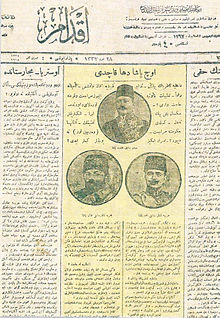
Armistice of Mudros and occupation
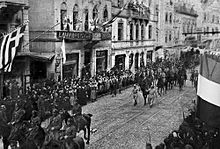
Prelude to resistance
The Armistice era
Politics of de-Ittihadification
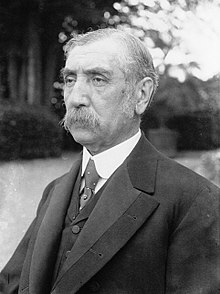
Banditry and the refugee crisis

Mustafa Kemal's mission
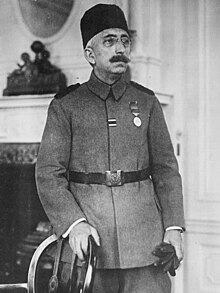
Negotiations for Ottoman partition
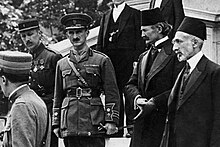
Organizational phase: May 1919 – March 1920
Greek landing at Smyrna
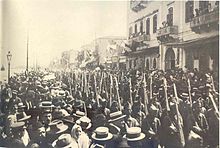
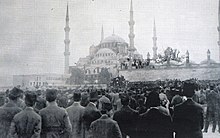
Organizing resistance
Consolidation through congresses
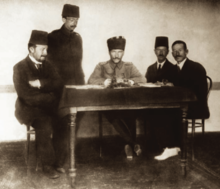
Last Ottoman parliament
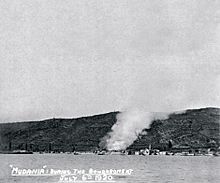
Jurisdictional conflict: March 1920 – January 1921
Decapitation of the Istanbul government
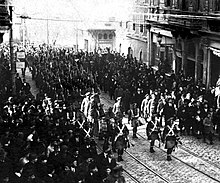
Promulgation of the Grand National Assembly

Clashes in İzmit
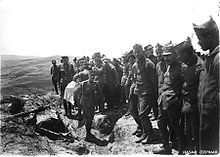
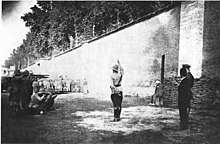
Treaty of Sèvres

Fighting
Southern Front
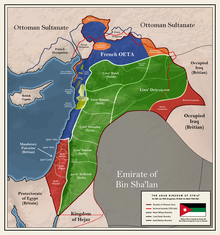
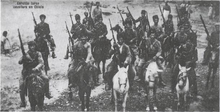
Al-Jazira Front
Eastern Front
Revolts
![]()
Western Front
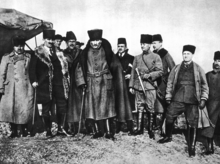
Peace negotiations and the Great Offensive (1921–1922)
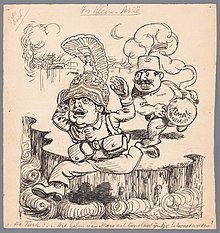
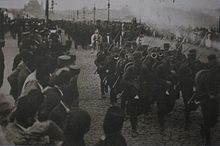
Armistice of Mudanya
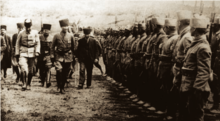
Outcome
Abolition of the sultanate
Treaty of Lausanne
Establishment of the Republic
![]()
Historiography
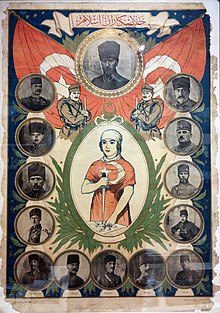
Impact
Ethnic cleansing
Turkey

Aftermath of the Chanak Crisis
Influence on other nations
![]()
See also
![]()
Notes
References
As such, the Greco-Turkish and Armeno-Turkish wars (1919–23) were in essence processes of state formation that represented a continuation of ethnic unmixing and exclusion of Ottoman Christians from Anatolia.
The Treaty of Lausanne in 1923 officially recognized the " ethnic cleansing " that had gone on during the Turkish War of Independence ( 1919 - 1922 ) for the sake of undisputed Turkish rule in Asia Minor .
The 'War of Independence' was not against the occupying Allies – a myth invented by Kemalists – but rather a campaign to rid Turkey of remaining non-Turkish elements. In fact, Nationalists never clashed with Entente occupying forces until the French forces with Armenian contingents and Armenian deportees began to return to Cilicia in late 1919.
The famous 'war of national liberation', prepared by the Unionists and waged by Kemal, was a vast operation, intended to complete the genocide by finally eradicating Armenian, Greek, and Syriac survivors.
While the number of victims in Ankara's deportations remains elusive, evidence from other locations suggest that the Nationalists were as equally disposed to collective punishment and population politics as their Young Turk antecedents... As in the First World War, the mass deportation of civilians was symptomatic of how precarious the Nationalists felt their prospects were.
Thus, from spring 1919, Kemal Pasha resumed, with ex- CUP forces, domestic war against Greek and Armenian rivals. These were partly backed by victors of World War I who had, however, abstained from occupying Asia Minor. The war for Asia Minor— in national diction, again a war of salvation and independence, thus in- line with what had begun in 1913— accomplished Talaat's demographic Turkification beginning on the eve of World War I. Resuming Talaat's Pontus policy of 1916– 17, this again involved collective physical annihilation, this time of the Rûm of Pontus at the Black Sea.
Ittihadist violence was as near as near could be optimal against the Armenians (and Syriacs) and in the final Kemalist phase was quantitively entirely the greater in an increasingly asymmetric conflict where, for instance, Kemal could deport "enemies" into a deep interior in a way that his adversaries could not..., it was the hard men, self-styled saviours of the Ottoman-Turkish state, and – culminating in Kemal – unapologetic génocidaires, who were able to wrest its absolute control.
Between 1920 and 1923, as Turkish and Western diplomats were negotiating the fate of the Armenian Question at peace conferences in London, Paris, and Lausanne, thousands of Armenians of the Ottoman Empire who had survived the massacres and deportations of World War I continued to face massacres, deportations, and persecutions across the length and breadth of Anatolia. Events on the ground, diplomatic correspondence, and news reports confirmed that it was the policy of the Turkish Nationalists in Angora, who eventually founded the Republic of Turkey, to eradicate the remnants of the empire's Armenian population and finalize the expropriation of their public and private properties.
The argument that there was a mutually signed agreement for the population exchange ignores the fact that the Ankara government had already declared its intention that no Greek should remain on Turkish soil before the exchange was even discussed. The final killing and expulsion of the Greek population of the Ottoman Empire in 1920–24 was part of a series of hostile actions that began even before Turkey's entry into World War I.
Mustafa Kemal completed what Talaat and Enver had started in 1915, the eradication of the Armenian population of Anatolia and the termination of Armenian political aspirations in the Caucasus. With the expulsion of the Greeks, the Turkification and Islamification of Asia Minor was nearly complete.
The Greek seizure of Smyrna and the repeated pushes inland— almost to the outskirts of Ankara, the Nationalist capital—coupled with the largely imagined threat of a Pontine breakaway, triggered a widespread, systematic four- year campaign of ethnic cleansing in which hundreds of thousands of Ottoman Greeks were massacred and more than a million deported to Greece... throughout 1914–1924, the overarching aim was to achieve a Turkey free of Greeks.
The genocide was committed by two subsequent and chronologically, ideologically, and organically interrelated and interconnected dictatorial and chauvinist regimes: (1) the regime of the CUP, under the notorious triumvirate of the three pashas (Üç Paşalar), Talât, Enver, and Cemal, and (2) the rebel government at Samsun and Ankara, under the authority of the Grand National Assembly (Türkiye Büyük Millet Meclisi) and Kemal. Although the process had begun before the Balkan Wars, the final and most decisive period started immediately after WWI and ended with the almost total destruction of the Pontic Greeks ...
Khilafat movement which was primarily designed to prevent the allied dismemberment of Turkey after World War One.
Bibliography
Concepts National
awakeningElections Issues Campaigns British (Allies) Revolts Armenia French Greek Agreements Allies Ottoman National
AssemblyFronts Field armies Corps/Area commands Fortified areas Others History Overview By topic Society and
its environmentOverview By topic Economy Overview By sector Government
and politicsNational security
in TurkeyCulture League of Nations Treaty of Versailles Subsequent treaties Treaty of Sèvres Other Paintings National Other

